
Obverse Side of Gros Tornois
"Gros Tournois of Louis IX. GROS. A coin of relatively large size: applied to silver coins of various…
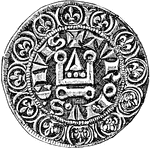
Reverse Side of Gros Tornois
"Gros Tournois of Louis IX. GROS. A coin of relatively large size: applied to silver coins of various…
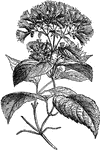
Guaco Branch
"Flowering branch of Guaco (Mikania guaco). GUACO. The Mikania Guaco, a climbing composite of tropical…

Guinea
"Guinea of Charles II., 1663. GUINEA. An English gold coin, of the value of 21 shillings, first issued…

French Guitar
"French guitar of 17th century. GUITAR. A musical instrument of the lute class, having usually six strings…

Gulden
"Silver gulden of William III., King of the Netherlands, 1867. GULDEN. One of several gold coins in…
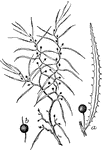
Gulfweed Branch
"Branch of Gulfweed (Sargassum bacciferum). a, vesicle with leaf; b, mucronate vesicle." -Whitney, 1911
Parts of the Gun
"Gun. A, breech; B, barrel; C, band; D, breech-block; E, butt; F, butt- or heel-plate; G, front sight…

Lyle Gun
"Lyle Life-saving Gun. LYLE GUN, a bronze life-saving gun, designed by Captain D. A. Lyle of the United…
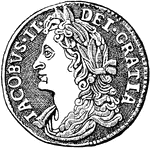
Obverse Side of Gun Money
"Obverse. Gun-money. Half-crown, 1689. GUN-MONEY. Money of the coinage issued by James II in Ireland…
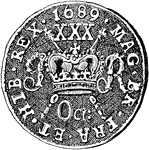
Reverse Side of Gun Money
"Reverse. Gun-money. Half-crown, 1689. GUN-MONEY. Money of the coinage issued by James II in Ireland…

Field Gun Carriage
"Field-gun Carriage. A, stock. B, cheek. a, lunette; b, trail-plate; c, c, pointing-rings; d, handle;…

Gun Lock
"Gun-lock. a, hammer or cock; b, tumbler; c, bridle; d, bridle-screw; e, sear; f, sear-screw; g, sear-spring;…

Gunwale
"G, G, gunwale; K, keel; T, thwart. GUNWALE, GUNNEL. Naut., the upper edge of a ship's side; the uppermost…
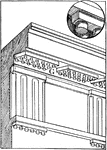
Gutta in Doric Architecture
"Guttae in Doric Architecture. A, form of gutta beneath regula; G, G, guttae beneath mutules and regulae.…
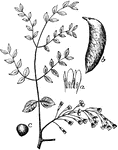
Kentucky Coffeetree
The Kentucky Coffeetree (Gymnocladus dioicus) is a tree in the Fabaceae family of legumes. It was also…
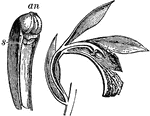
Gynandria of Bletia
"Gynandria. A, section of flower of Bletia' B, separated column of same, composed of the united style…

Borage Gynoecium
"Gynobase. Section of Gynoecium of Borage, gynobase (a) bearing the carpels and style." -Whitney, 1911
Gynandropsis
"Flower of Gynandropsis. a, gynophore. GYNOPHORE. In botany, an elongation or internode of the receptacle…
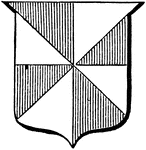
Gyronny
"Gyronny of eight, gules and argent. GYRONNY. In heraldry, dividend into a number of triangular parts…
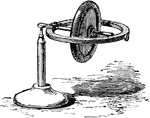
Gyroscope
"Gyroscope. Gyroscopic top, an instrument consisting of a heavy fly-wheel revolving about an axis one…

Nautiloid
"Gyroceras goldfussi. GYROCERATIDAE. A family of nautiliform shells of a discoidal shape, in which the…

Foucault's Gyroscope
"Foucault's Gyroscope. GYROSCOPE. An instrument consisting of a fly-wheel, the axis of which can turn…
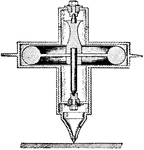
Gyrostat
"Gyrostat. An instrument for illustrating the dynamics of rotation, composed of a box or case having…

Rabbit Brain
"Brain of rabbit. Ol, olfactory lobe; A, B, C, frontal, occipital, and temporal lobes; Sy, Sylvian fissure."…

Pig Brain
"Brain of pig. Ol, olfactory lobe; A, B, C, frontal, occipital, and temporal lobes; C1, a portion of…

Chimpanzee Brain
"Brain of chimpanzee. Ol, olfactory lobe; A, B, C, frontal, occipital, and temporal lobes; C1, a portion…
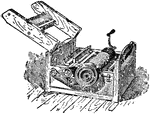
Whitney's Cotton Gin
A machine which separated the seeds from raw cotton more rapidly than could be done by hand.

Salvadora
Salvadora Persica. Also called toothbrush tree, mustard tree, and mustard bush. This image includes…

Sand Pump
"1. In rope-drilling, a cylinder, provided with a valve at the bottom, which is lowered into the drill-hole…
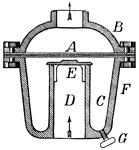
Sand Trap
Part of a hydraulic engine. "A device for separating sand and other heavy particles from running water.…
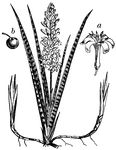
Snake Plant
Sansevieria Zeylanica is the Latin name, but this plant is also called a Mother-in-law's Tongue. "A…

Satellite Sphinx Moth
"Philampelus satellitia, a large and handsome hawk-moth whose larva feeds upon the vine. Natural size.…
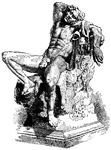
The Barberini Faun, or Drunken Satyr
Illustration of the life-size marble statue located in Munich, Germany. It was found in 1620 in a moat…
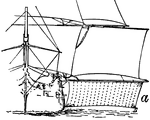
Save-All, or Catch-All
"A small sail set under another, or between two other sails, to catch or save the wind." —Whitney,…
Sawfish, Side View
Pristis pectinatus. "1. An elasmobranchiate or selachian fish of the family Pristidae, having the snout…

Collection of Saw-Sets
A saw-set is an "instrument used to wrest or turn the teeth of saws alternately to the right left so…
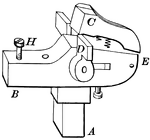
Saw Set for a Work Bench
"a. shank for fixing the implement to a bench; c. punch, hinged to a base b and e; and pressed upward…
Scabbard Fish
Lepidopus caudatus. "1. A fish of the family Lepidopodidae, Lepidopus caudatus,of the Mediterranean…
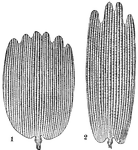
Scales from the Wings of a Butterfly
"Scales from the wings of a butterfly, Vanessa antiopa, highly magnified. 1. from border of anterior…

Scalpriform, Left Lower Incisor of a Beaver
Close-up illustration of scalpriform incisor of a beaver. It is "chisel-shaped; having the character…
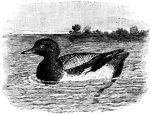
Scaup, a Common Duck
"A duck, Fuligula or Fulix marila and related species. The common scaup inhabits Europe, Asia, and North…

Sceat, an Early Anglo Saxon Coin
"Specimens occur in gold, but most frequently in silver. Their average weight is 15 grains, and they…

The Scorpio Constellation, with Libra
"The constellation which is prominent in early summer in the skies of the southern United States (where…
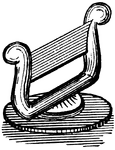
Scraper for Shoes at the Front Door of a House
"An iron implement placed at or near the door of a house, on which to scrape the dirt from the soles…

Scraper, Meant to be Drawn by Oxen or Horses
"An apparatus drawn by oxen or horses, and used for scraping the earth in making or repairing roads,…

Ship Scraper
"An instrument having two or three sides or edges for cleaning the decks, masts, or planking of ships,…

Collection of Wood Scrapers
"A wood-working tool with a straight or a curved blade and with one or two handles, used to remove address-marks…

Scrapers for Making Cabinets
"A tool used by cabinet-makers in dressing off and smoothing veneers, etc." —Whitney, 1889 The…
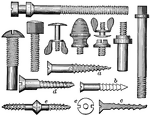
Collection of Screws Used in Carriage-Making and Carpentry
A number of screws, all used in carriage-making and carpentry. "A, B, C, D, and E are special forms…
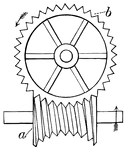
Hindley's Screw
"A screw cut on a solid, of such form that if any plane be taken through its longitudinal axis, the…

Screw Propeller, Side Elevation
"A propeller acting on the principle of the screw, attached to the exterior end of a shaft protruding…
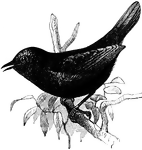
Magellanic Tapaculo
Scytalopus magellanicus. "A genus of South American formicarioid passerine birds, of the family Pteroptochidae.…

Elephant Seal on a Rock
"The seal Macrorhinus elephantinus or proboscideus, or Morunga proboscidea. It is the largest of the…

Leopard Seal
Leptonychotes weddelli. "A spotted seal of the southern and antarctic seas, belonging to the family…
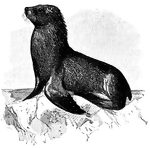
Sea Lion
Otaria jubata. One of several large eared seals, or otaries. Also called "Cook's otary" or the "Patagonian…

Seal Press
"A press or stamp bearing dies on its jaws, or a die and a bed, for imprinting or embossing any device…

Circle with Secant
A secant is "a line which cuts a figure in any way. Specifically, in trigonometry, a line from the center…
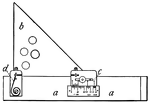
Section Liner, A Draftsman's Tool
"A draftsman's instrument for ruling parallel lines. It consists of a triangle so attached to a straight-edge…
Sawfish, View from Underneath
Pristis pectinatus. "1. An elasmobranchiate or selachian fish of the family Pristidae, having the snout…